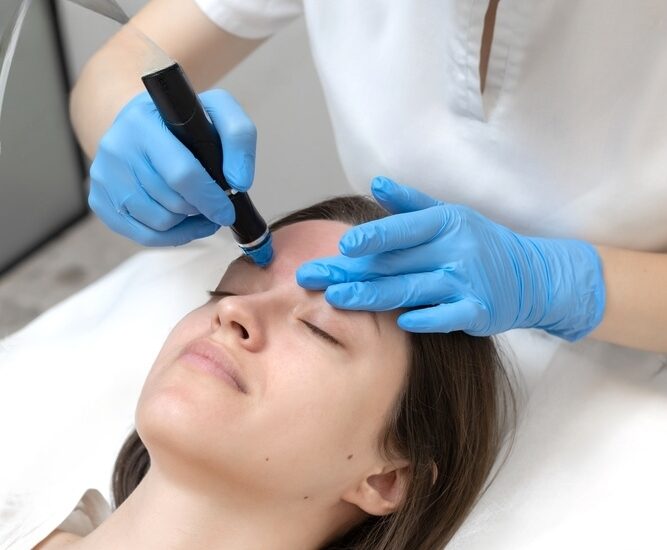Achieving youthful-looking skin is a universal desire, but dark circles under the eyes can be a significant hindrance. As we age, facial skin tissues lose elasticity, causing the skin under the eyes to appear thin and sunken, resulting in a hollowed facial appearance. Factors such as a poor diet, stress, inadequate sleep, collagen loss, and dehydration can also contribute to the formation of dark undereye circles. If you’re experiencing this issue, consulting an expert dermatologist for Undereye Fillers in Islamabad, Rawalpindi, and Pakistan can be a viable solution.

What Are Under Eye Fillers:
Injecting dermal fillers under the eyes is a straightforward solution to restore lost volume due to aging. These aesthetic fillers are versatile, injectable substances that can address various concerns, including hollowness, dark circles, eye bags, and deep tear troughs. Hyaluronic acid-based dermal fillers are the most suitable option for use under the eyes, offering effective and natural-looking results.
Types of under-eye fillers:
There are many types of under-eye fillers, including hyaluronic acid fillers, calcium hydroxylapatite fillers, and polymethylmethacrylate (PMMA) fillers:
- Hyaluronic acid fillers
- Calcium hydroxylapatite fillers
- Polymethylmethacrylate (PMMA) fillers
- Polylactic acid
- Platelet-rich plasma
How Does It Work:
Dermal fillers effectively fill in the hollows under the eyes, restoring natural contours and promoting collagen production, which smoothens the facial skin. Hyaluronic acid-based dermal fillers are the preferred choice for under-eye treatments. By binding water molecules, hyaluronic acid provides hydration and lubrication to the skin, mimicking the effects of natural hyaluronic acid. When used in dermal fillers, it revives and rejuvenates the skin, yielding a youthful appearance. Upon injection, hyaluronic acid-based dermal fillers act like sponges, expanding to fill in facial folds and areas that have lost volume, ultimately enhancing the overall appearance.
What To Expect in Results:
The results of under-eye fillers are temporary, typically lasting between two to three years. To maintain the desired outcome, occasional touch-up sessions are necessary. While some noticeable improvements can be observed within 3-4 days after the injection, the final results usually become apparent 14-21 days later. A significant advantage of this procedure is its reversibility, allowing the skin to quickly return to its natural state if you’re dissatisfied with the results.

Top Benefits:
- Dark circles
- Long-lasting results
- Refresh eye area
- Wrinkles
- More youthful look
- Restored volume under the eyes
- Makes you look younger
Who are suitable candidates:
To be a suitable candidate for under-eye fillers, you should meet the following criteria:
- You have prominent dark circles under your eyes.
- You desire improvement in your facial contours.
- You need to repair collagen loss under your eyes.
- You're looking for a non-invasive treatment option.
- You want to maintain a youthful appearance for a longer period.
- You want to address dark circles caused by pigmentation or sun exposure.
How To Prepare For The Treatment:
To ensure a smooth and safe treatment experience, your practitioner will advise you to follow these precautions before the procedure:
- Reduce alcohol consumption and quit smoking at least two weeks prior to treatment
- Avoid anti-inflammatory medications to minimize the risk of complications during recovery.
- Refrain from taking vitamin E supplements for at least one week before treatment.
- Stay hydrated by drinking plenty of water 48 hours before your scheduled appointment.
The procedure of undereye fillers:
The under-eye filler procedure is a straightforward process that typically takes 20-40 minutes, performed by an experienced practitioner. Here are the step-by-step procedural details:
- 1. The injection site is marked, cleaned, and sterilized.
- Local anesthesia is injected into the desired area, and the practitioner waits for it to take effect.
- A cannula containing the filler solution is inserted into the under-eye area through a small skin puncture made by a needle.
- Alternatively, a single needle may be used to puncture the skin and inject the filler solution, especially in smaller treatment areas, requiring only one or two injections.
- After injecting the filler, the surgeon gently smooths the area to ensure even distribution and a natural appearance.
Aftercare instructions:
To ensure a smooth recovery and minimize potential side effects, it’s essential to follow proper aftercare instructions for your treated area.
These side effects are temporary and typically resolve within 3-4 days. In some cases, your doctor may prescribe medication to manage pain or inflammation.
Since under-eye fillers are a non-invasive procedure, there is no required downtime. You can resume your daily activities and return to work immediately after the treatment.
Book Your Appointment With Us!

Understanding Acne: Causes, Treatments, and Prevention
September 24, 2024

Summer Skincare Tips: How to Beat the Heat
September 24, 2024

Hydrafacial for Acne-Prone Skin
September 24, 2024

Hair Transplant Techniques: FUE vs. FUT Explained
September 24, 2024

Understanding Alopecia: Types, Causes, and Treatment Options
September 24, 2024

Hydrafacial: The Ultimate Treatment for Healthy, Glowing Skin
September 24, 2024
The Importance of Regular Skin Check-Ups: Why Dr. Abbas Shah Recommends Them
September 24, 2024

Acne Treatment
September 24, 2024

Hydra Facial
September 24, 2024

Micro Hair Transplant
September 24, 2024

Alopecia
September 24, 2024

PRP Therapy
September 23, 2024

Botox
September 22, 2024
